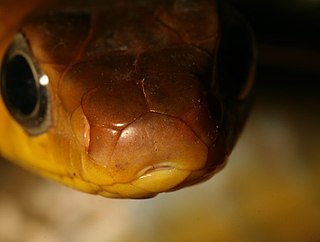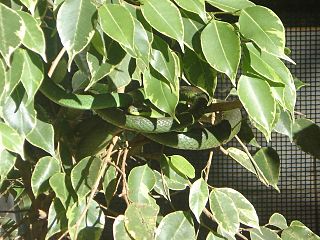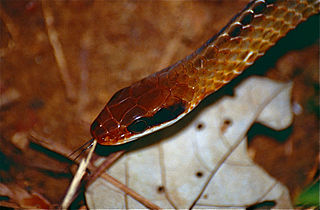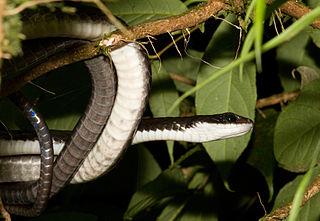
A booby is a seabird in the genus Sula, part of the family Sulidae. Boobies are closely related to the gannets (Morus), which were formerly included in Sula.

Chironius multiventris, commonly known as the long-tailed machete savane, is species of colubrid snake.

Chironius carinatus, commonly known as the Amazon coachwhip, is a long and slender, nonvenomous colubrid snake.

Chironius is a genus of New World colubrid snakes, commonly called sipos, savanes, or sometimes vine snakes. There are 23 described species in this genus.

Itapotihyla is a genus of frogs in the family Hylidae. It is monotypic, being represented by the single species Itapotihyla langsdorffii, commonly known as the ocellated treefrog. It is found in the Atlantic Forest biome of Brazil, with an isolated population in eastern Paraguay and adjacent Brazil and northeastern Argentina.
The Saint Vincent blacksnake, also commonly known as the Saint Vincent coachwhip, the San Vincent racer, and Vincent's sipo, is a species of snake in the family Colubridae.
Raymond Ferdinand Louis-Philippe Laurent was a Belgian herpetologist, who specialized in African and South American amphibians and reptiles. He published more than 200 scientific articles and book chapters. Several species have been named after him, most recently Phymaturus laurenti in 2010. Additional species of reptiles named in his honor include Chironius laurenti, Liolaemus laurenti, and Mehelya laurenti.

Chironius laurenti is a species of nonvenomous snake in the family Colubridae. The species is endemic to Bolivia and Brazil. The species was named in honor of Raymond Laurent.

Chironius exoletus is a species of snake of the family Colubridae. It is commonly known as Linnaeus's sipo.

The brown sipo is a species of snake of the family Colubridae.

Chironius flavolineatus, also known as Boettger's sipo, is a vine snake species in the family Colubridae, endemic to savannas and semiarboreal biomes in Brazil, and much of South America. It is listed as least concern on the IUCN Red List since 2014. It is a member of the Genus Chironius which is composed of twenty-two other described snake species. It is nonvenomous, using camouflage or burrowing as a form of defense.

Chironius bicarinatus, the two-headed sipo, is a species of snake in the family Colubridae. The species is found in Brazil, Argentina, Uruguay, and Paraguay.

Chironius brazili is a species of snake in the family Colubridae. The species is found in Brazil.
Chironius flavopictus is a species of snake in the family Colubridae. The species is found in Panama, Costa Rica, Colombia, and Ecuador.

Chironius foveatus, the South American sipo, is a species of snake in the family Colubridae. The species is found in Brazil.

Chironius grandisquamis, the Ecuador sipo, is a species of snake in the family Colubridae. The species is found in Honduras, El Salvador, Nicaragua, Costa Rica, Panama, Ecuador, Peru, Bolivia, and Colombia.
Chironius laevicollis, the Brazilian sipo, is a species of snake in the family Colubridae. The species is found in Brazil.
Chironius maculoventris, the central sipo, is a species of nonvenomous snake in the family Colubridae. The species is found in Argentina, Paraguay, Bolivia, and Brazil.
Chironius monticola, the mountain sipo, is a species of nonvenomous snake in the family Colubridae. The species is found in Venezuela, Ecuador, Bolivia, and Peru.












